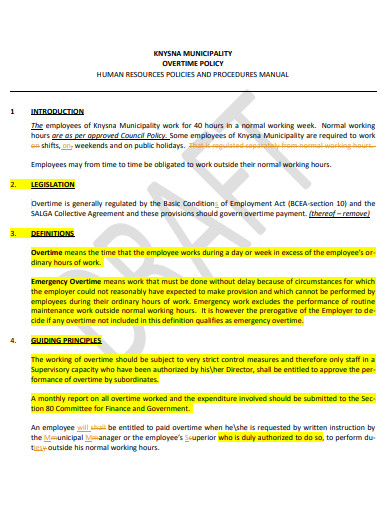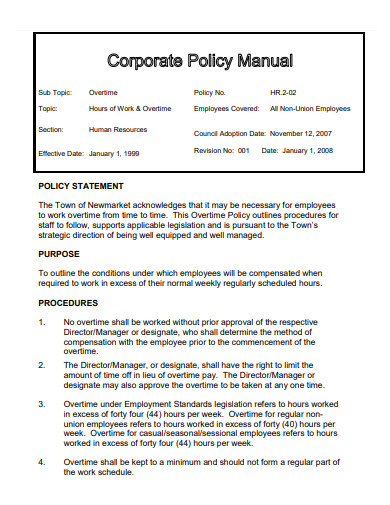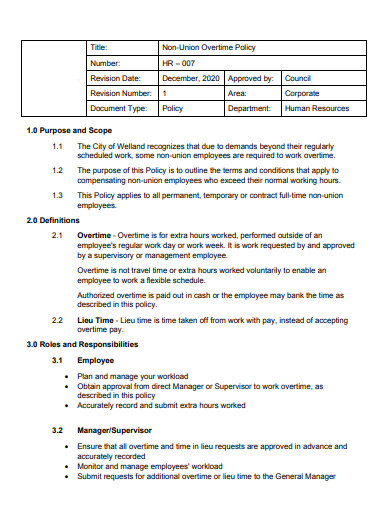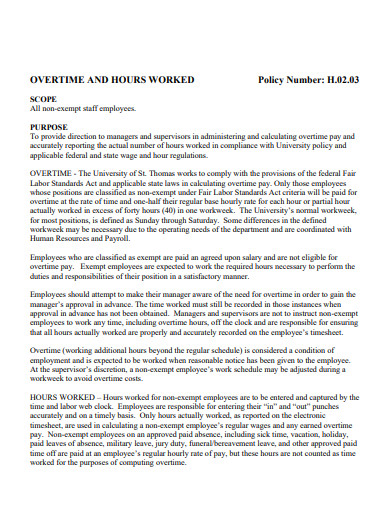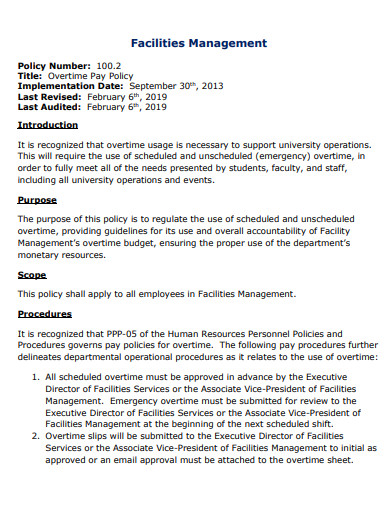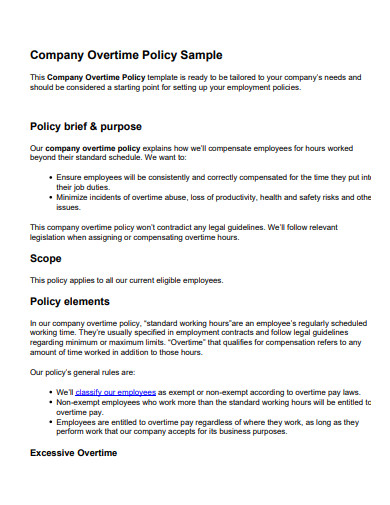Working overtime (beyond the contractual working hours) can adversely affect your employees’ health and well-being. However, sometimes, employees will have to put in overtime to meet weekly targets and client expectations. That’s why it’s essential to have an excellent overtime policy that covers every aspect of working overtime in your organization. In this article, you’ll learn the benefits of an overtime policy and what goes into creating one. We’ll also give a free overtime policy template to help you create your own policy easily.
10+ Overtime Policy Samples
1. Overtime Policy
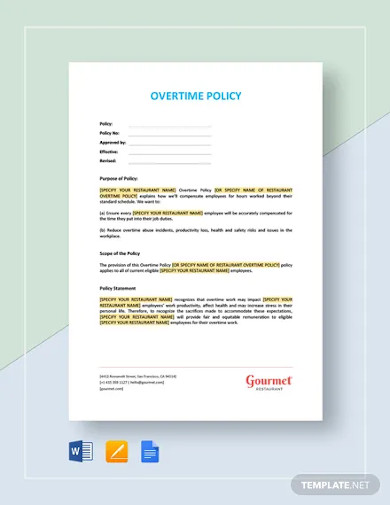
2. Company Overtime Policy
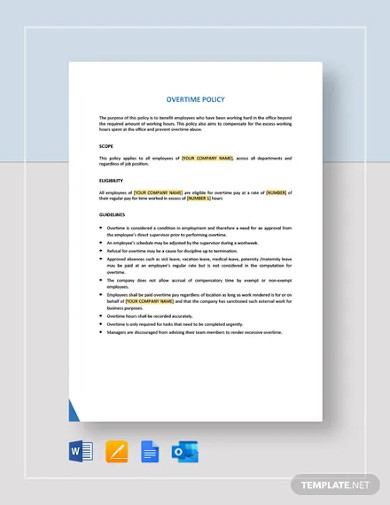
3. Overtime Pay Policy
4. Muncipality Overtime Policy
5. HR Overtime Policy
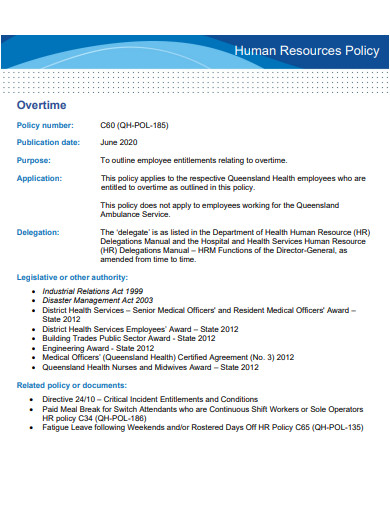
6. Corporate Overtime Policy
7. Non-Union Overtime Policy
8. Overtime and Hours Worked Policy
9. Sample Overtime Policy
10. Company Overtime Policy Example
11. Formal Company Overtime Policy
What is an Overtime Policy?
A company’s overtime policy is an official document that defines who can apply for overtime hours, along with how they can do it while specifying when they can do it. This means that whenever an employee needs extra time to finish up a project, they can apply for overtime to complete it. Although every employee can usually volunteer for overtime, not all of them get paid for it. According to the Fair Labor Standards Act (FLSA) of the Department of Labor in the US, employees are categorized as being either an exempt employee or a non exempt employee. While a non-exempt employee’s regular rate of pay increases by one-half times when they put in time beyond their 40-hour workweek, exempt employees don’t share the same privilege.
Details to Include in an Overtime Policy
1. Exempt vs. nonexempt employees
Your overtime policy must address the difference between exempt and nonexempt employees. Explain that nonexempt employees receive overtime wages for hours over 40 worked while exempt employees don’t.
In addition to outlining this difference, you should also tell employees which classification they are when you hire them.
2. Whether overtime is mandatory, optional, or prohibited
Depending on your business, you might want to make overtime mandatory, optional, or off-limits.
If you need employees to work overtime, particularly during the busy seasons, you might establish weeks with mandatory overtime. State how many hours of overtime each employee is required to work during these times.
Some businesses don’t need employees to work overtime, but they don’t outright ban it. If this sounds like something that would be the case in your business, you might make overtime optional.
Overtime for nonexempt employees can get expensive. To avoid these high costs, you might ban employees from working overtime.
3. Overtime limitations, if applicable
Instead of completely banning employees from working overtime, you might decide to limit the number of overtime hours they can work. If you do decide to limit overtime, add it to your policy.
For example, you can specify that your employees can work a maximum of four overtime hours each week (per employee).
By limiting overtime hours, you can control the amount of overtime pay you need to dole out to your employees.
4. Procedures for working overtime
Your employee overtime policy should dive into specifics. Mention how employees request to work overtime, whether there is an overtime rotation, and how employees report overtime hours worked.
Specify whether you have an overtime approval policy—do employees need to get permission before working extra hours in a workweek? If employees need to get approval before working overtime, explain how.
Some businesses use an overtime rotation policy to split up overtime hours among different employees or departments. If you rotate who gets to work overtime, outline it in your policy.
Don’t forget to explain how employees report their overtime hours. Will they clock-in using a time clock or mark their hours in an online time and attendance system?
5. How overtime is paid out
Generally, overtime wages are included in a nonexempt employee’s regular wages when you run payroll.
If you forget to pay overtime wages, you must provide back pay to the employee. When you pay an employee back pay, you can run a separate payroll for the wages or include them in the employee’s next paycheck.
Also, remember to withhold taxes from overtime wages. Because overtime pay is a type of supplemental pay, you can either withhold taxes like you would regular wages or use the supplemental tax rate of 22%.
Your policy should specify how nonexempt employees receive their overtime pay. And, state what employees should do if they think there is a problem with their overtime wages.
FAQs
Why a company needs an overtime policy?
- Transparency and Non-Discrimination: An overtime policy covers every aspect of working overtime – including the payment process for both employees and managers. This not only makes every employee aware of your company’s overtime provisions but automatically prevents any discrimination in compensation or overtime grants.
- Unexploited Working Hours: With an overtime policy, no manager can compel any fulltime/halftime/staff employees to work beyond their work schedule until they need overtime to complete their tasks. Employees also won’t be able to use overtime to get promotions or better compensation. This ensures that both your employees’ health and productivity are managed properly.
- Monitor Employee Work : An overtime policy not only clarifies the overtime reporting and monitoring process but also outlines the overtime approval procedure. By mentioning the mode of tracking employee hours, both managers and employees get clarity on the monitoring procedure. Apart from providing you with the number of hours for accurate pay calculation, this record keeping also makes you aware of their productivity during their regular working hours.
What is the difference between exempt and non-exempt employees?
An exempt employee is not entitled to overtime pay according to the Fair Labor Standards Act (FLSA). To be exempt, you must earn a minimum of $684 per week in the form of a salary. Non-exempt employees must be paid overtime and are protected by FLSA regulations.
Whether you’re only employing non-exempt employees or employing both kinds of workers, creating an overtime policy sorts out most of your troubles. You’ll be able to clarify all employee concerns, ensure legal compliance and save on extra overtime expenses. To help you get started making the overtime policy, download our free sample templates above to use as your guide!
Related Posts
FREE 10+ Charity Donation Policy Samples and Templates in MS ...
FREE 8+ Sample Refund Policy Templates in MS Word PDF
FREE 10+ Employee Attendance Policy Samples in PDF MS Word
FREE 10+ Grievance Procedure Policy Samples [ Company ...
FREE 10+ Sample Investment Policy Statement Templates in MS ...
FREE 12+ Dress Code Policy Samples in MS Word Google Docs ...
FREE 11+ Assignment of Insurance Policy Samples in PDF MS Word
FREE 9+ Sales Commission Policy Samples & Templates in PSD ...
FREE 10+ Administration of Medication Policy Samples & Templates ...
FREE 9+ Cancellation Policy Templates in PDF
FREE 13+ Policy and Procedure Templates in PDF
FREE 10+ Internal Complaint Policy Samples & Templates in MS ...
FREE 10+ Charity Complaints Procedure Policy Samples ...
FREE 12+ Health and Safety Policy Templates in Google Docs ...
FREE 19+ Sample Company Policy Templates in PDF MS Word ...


